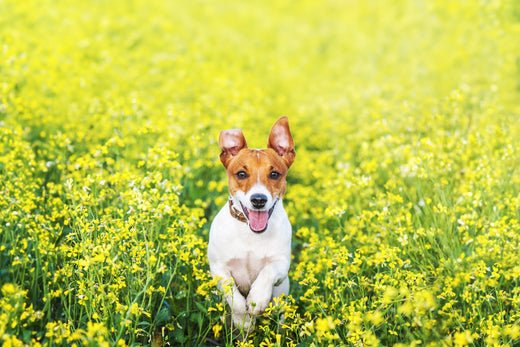Spring is here! The sun is shining, nature is blooming, and the days are getting longer. A reason to rejoice for us humans – but what does that actually mean for our dogs? In this article, you'll learn whether dogs really experience spring fever, what the breeding and nesting season is all about, and how to protect your four-legged friend from parasites like ticks.
Do dogs have spring fever?
Yes, dogs feel spring too! The rising temperatures, longer days, and the awakening of nature also affect your dog's mood. He becomes more curious, more alert, and seems to perceive the new scents with particular intensity.
Intact dogs—that is, unneutered males and females—are particularly sensitive to the spring season. Female dogs that are in heat now emit hormonal signals that can literally "enchant" the males. Even neutered dogs often show increased interest in their surroundings and more energy on walks.
The breeding and nesting season: Consideration is required
March to July is the breeding season. This means that wild animals such as birds, deer, and hares are raising their young. Special care is required during this time, as dogs running loose can pose a serious threat to wild animals and their young.
Why is the breeding and nesting season so important?
Even a well-trained dog can scare off wildlife or injure young animals through instinctive behavior. Therefore, in many German states, dogs must be kept on a leash in forests and meadows during this time.
Tips for walks during the breeding and nesting season:
- Keep your dog on a leash, especially in nature reserves or on the edge of forests.
- Stay on marked trails and avoid tall grass where young animals might hide.
- Practice recall so you can control your dog in any situation.
Ticks and parasites in spring: An underestimated danger
As temperatures rise, parasites such as ticks, fleas, and mites become active again. Ticks, in particular, pose a major threat, as they can transmit diseases such as Lyme disease, anaplasmosis, and babesiosis.
How do you protect your dog from parasites?
- Tick repellents : Spot-ons, collars or tablets are effective ways to keep ticks away.
- Coat check: After every walk, you should thoroughly check your dog for ticks – especially on the stomach, ears, and paws.
- Keep tick tweezers handy: Remove ticks quickly and completely to prevent infection.
Fleas and mites can also become a problem again in spring. Regular grooming and preventative measures will help keep your dog parasite-free.
Dog hair everywhere? Spring brings the change of fur
In addition to spring fever and parasites, many dogs also experience a coat change in spring. The thick winter fur is shed, and the summer coat grows in.
How to support your dog during the coat change:
- Brush your dog regularly to remove loose hair and stimulate the skin.
- Make sure you provide a balanced diet with sufficient omega-3 fatty acids to keep the coat healthy.
- Vacuum and clean your home regularly – spring brings with it lots of dog hair!
Flowering plants: Not everything is harmless
In spring, nature blooms – but be careful: Many plants that sprout now are poisonous to dogs. Examples include oleander, tulips, daffodils, and daffodils.
What to do if your dog has nibbled on a plant?
- Consult a veterinarian immediately if your dog shows symptoms of poisoning (vomiting, diarrhea, tremors).
- Avoid poisonous plants in the garden or place them out of your dog's reach.
Conclusion: Spring – an exciting time for your dog
Spring brings new energy and plenty of adventures, but also some challenges for you and your dog. Whether it's spring fever, the breeding and nesting season, or protection from parasites – with a little preparation, you can enjoy the spring months to the fullest. So get out into nature, but please be considerate of the environment and provide good protection for your four-legged friend!



